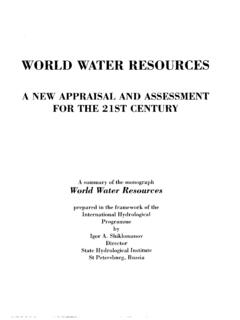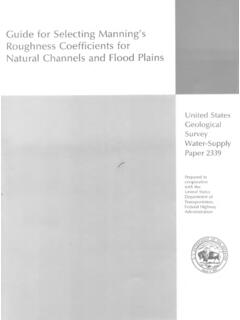Transcription of 3.2 Topic 8: Open Channel Flow - University of Texas at Austin
1 1 Course Number: CE 365 KCourse Title: Hydraulic Engineering Design Course Instructor: Charbeneau Subject: open Channel Hydraulics Topics Covered:8. open Channel Flow and manning Equation9. Energy, Specific Energy, and Gradually Varied Flow10. Momentum (Hydraulic Jump)11. Computation: Direct Step Method and Channel Transitions12. Application of HEC-RAS13. Design of Stable 8: open Channel FlowGeomorphology of Natural Channels:Geomorphology of natural channels concerns their shape and structure. Natural channels are of irregular shape, varying from approximately parabolic to approximately trapezoidal (Chow, 1959).Trapezoidal Geometry Characteristics Depth, y Area, A Wetted perimeter, P Top width, THydraulic Radius, Rh= Area / Wetted perimeterHydraulic Depth, Dh= Area / Top ChannelIf 0 < (4 a y)1/2< 1 Example #12: Parabolic ChannelA grassy swale with parabolic cross-section shape has top width T = 6 m when depth y = m while carrying stormwater runoff.
2 What is the hydraulic radius? in open Channels: manning EquationManning s equation is used to relate the average Channel (conduit) velocity to energy loss, Sf= equation (metric units: m, s)UNITS ?!!? Does n have units? Tabulated values? Equation (Cont.)General caseTo change to US Customary units multiply by = 1 (metric) or (English) Conveyance, KK = ( /n) A Rh2/3 For manning s equation, K combines roughness and geometric characteristics of the channelManning s equation: Q = K Sf1 and manning s nEquivalence between roughness size (k) and manning s n:n = k1/6(k in ft)Examplesnk (cm)Concrete (finished) Channel (gravel) Channel (clean) (light brush) 300 Strickler (1923) * Compare with manning s n for sheet flow6 Grassed ChannelsSCS (after Chow, 1959) Retardance Class (Table )Figure , page 311, V RhEnglish Units (ft, s)Example #13.
3 Estimate the Channel discharge capacity for So= Channel from Far West Pond7 Example #13: Qmax(cfs) =1. For grass channels, use Slide Guess an initial value n = Geometry:Bottom width, b = 5 ft (~)Side slope (z:1), z = 2 Maximum depth, y = 4 ft-------------------------------------- -Hydraulic radius, Rh= ftVelocity, V = Q = 240 ft3/s V Rh= ft2/s Example #13 (Cont.)V Rh> 10 ft2/s n = (slide ) 400 cfs8 Normal DepthNormal depth is the depth of uniform flowin an prismatic open Channel . Since the flow is uniform, the depth and discharge are related through manning s equation with Sf= Q, n, A(y), Rh(y) and So: solve for ynWaves (Small Disturbances) in a Moving StreamcyVWave (disturbance) can move upstream if Number9 Critical Depth Froude numberCritical flow occurs when the velocity of water is the same as the speed at which disturbances of the free surface will move through shallow water.
4 The speed or celerityof disturbances in shallow water is given by c = (g Dh)1/2, where Dhis the hydraulic depth. Critical flow occurs when v = c, or more generallyImportantly, critical depth is independent of the Channel 9: Energy, Specific Energy, and Gradually Varied FlowClosed Conduit: open Channel Energy Equation:zB z hereafter10 Energy in open ChannelsSpecific EnergyKinetic Energy Correction Slope:Sf= - dH/dxChannel Slope:So= - dz/dxxWhat do we do with ? For simple channels assume = 1 For complex channels (main Channel plus left and right-bank floodplains), velocity variation at a given station can be significant, and should be calculated and used in a 1D energy equation (HEC-RAS does this automatically!)
5 Energy Coefficient, 12 3A1, P1, n1A2, P2, n2A3, P3, n3 Main ChannelRight OverbankLeft Energy, EHydraulic energy head measured with respect to the local Channel bottom, as a function of depth yEyFor fixed depths12 Specific Energy at Critical FlowRectangular Channel : Dh= yE = V2/2g + y = [(1/2) (V2/gy) + 1] y = (1/2 + 1) yFor critical flow (in a rectangular Channel ):y = (2/3) EV2/2g = (1/3) NumberEnergy EquationE2+ z2= E1+ z1+ hL(2 1)Head Loss: Major Losses friction losses along Channel Minor Losses Channel expansion and contraction E = Specific Energy = y + V2 Losses in open Channel Flow: Slope of the EGL: Sf= hf/ LManning s equation: Q = K Sf1/2 Bed-friction head loss: hf= (Q/K) (Expansion and Contraction) LossesEnergy losses at Channel expansions and contractions values: Channel Contraction - C = Expansion -C = Expansion.
6 (C = 1)14 Gradually Varied Flow ProfilesPhysical laws governing the head variation in open Channel flow1) Gravity (So) is the driving force for flow2) If So= Sfthen dE/dx = 0 and flow is uniform (normal depth)3) Gravity (So) is balanced by friction resistance (Sf) and longitudinal adjustment in specific energy (dE/dx)4) Adjustments in specific energy are constrained through specific energy Varied Flow: Mild Slope (yn> yc)1. Point 1 (M1 Curve): y > yn Sf< So dE/dx > 0 depth increases downstream2. Point 2 (M2 Curve): y < yn Sf> So dE/dx < 0 depth decreases downstream3. Point 3 (M3 Curve): y < yc< yn Sf> So dE/dx < 0 depth fixed Qyn123yc15 Mild SlopeNote that for the M1 and M2 curves, the depth approaches normal depth in the direction of flow computation for subcritical Varied Flow: Steep Slope (yn< yc)1.
7 Point 1 (S1 Curve): y > yc> yn Sf< So dE/dx > 0 depth increases downstream2. Point 2 (S2 Curve): y > yn Sf< So dE/dx > 0 depth decreases downstream3. Point 3 (S3 Curve): y < yn Sf> So dE/dx < 0 depth increases fixed Qyn123yc16 Steep SlopeNote that for curves S2 and S3 the depth approaches normal depth in the direction for flow computation for supercritical Slope (So= 0) 10: Momentum and Hydraulic JumpFBv1v2yp= depth to pressure center (X-section centroid)Momentum Equation: F = Q (V2 V1) yp1A1 yp2A2 FB= Q2(1/A2 1/A1)Write as: M1= M2+ FB/ Specific Force: M = ypA + Q2/(g A) JumpySpecific force, M12 Sequent (Conjugate)18 Energy Loss and Lengthy1y2 LjyjEnergy Loss:Exercise: convince yourself that this is the same as E = E1 Length.
8 Lj= yj= (y2 y1) ChannelExample #14: Normal depth downstream in a trapezoidal Channel is m when the discharge is 15 m3/s. What is the upstream sequent depth? mHow do you find the energy loss? E = mPower = 11: Direct Step Method and Channel TransitionsReturning to the Energy EquationStep calculationSolve for Step Method: ApproachIn this case you select a sequence of depths and solve for the distance between them: y1, y2, y3, .. With known y: E1, E2, Q2/2gA2, etc. are calculated The average friction slope is calculated #15: Channel Transitionb1= 2 mb2= mz1= 1 Control section Fr = 15 mHeadwater = ?What is the headwater upstream of a control section in a downstream box culvert: Q = 10 m3/s; Channel n = Section: V = (g Dh) (g y) Q = (g y) (b y)y = [Q / b ]2/3= #15 (Cont.)
9 : Specific m depth in the upstream Channel (Section 1, blue) corresponds to specific energy E = m, compared with E = m in the control section. The upstream E2must exceed m, which requires an increase in depth. 21 Example #15 (Cont.): Direct Step a 5-m long transition section. Adjust depth until x = 5 m y2= mResulting upstream specific energy is E2= m. Contraction losses at entrance ~ 6 cmFriction losses in transition section ~ 1 cmExample #16: Specific Energy and Channel Transitions Trapezoidal Channel with b = 8 ft, z = 2, n = Normal depth occurs upstream and downstream. Rectangular culvert (b = 5 ft, n = ) added with concrete apron extending 10 feet downstream from culvert outlet.
10 Develop flow profile, especially downstream of the culvert, for Q = 250 #16 (Cont.): Normal and Critical Depth in Main ChannelUpstream and Downstream Channel haveyn= ftyc= > yc Mild Slope Downstream ControlEx. # 16 (Cont.): Normal and Critical Depth in ftyc= ftyn< yc Steep Slope Upstream control23Ex. #16 (Cont.): Specific Energy depth upstream and downstreamNormal depth:E = ftMinimum specific energy in culvert:E = ftTo enter the culvert from upstream, specific energy increased through M1 curve(Culvert as choke )Ex. #16 (Cont.) Upstream Transition and Entry to CulvertCulvertChannel1M1 curveControl in culvert2 Trapezoidal Channel M1 CurveHeadwater = #16 (Cont.)





